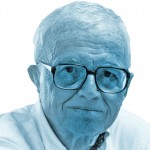
Of all the travel books on my shelves, faithful reminders of places I once traveled far to see, one that often tugs at me is Garden Islands of the Great East: Collecting Seeds from the Philippines and Netherlands India in the Junk “Chêng Ho,” by David Fairchild. That’s a book I’m highly unlikely to own; botany is a subject I’ve never been accused of boring my friends with. Yet if I open Fairchild’s 1943 book to its endpapers, I see a map of the voyage he made in 1940 through the Moluccas, the old Spice Islands of the Dutch East Indies, to gather plants for what would become the Fairchild Tropical Gardens in Coral Gables, Florida. Tracing his route, I can still smell the copra boat I took through those same Moluccas in 1953, and I think with gratitude of the writer who sent me there.
S. J. Perelman was a licensed humorist practicing his trade when the editor of Holiday magazine, Ted Patrick, who elevated the craft of travel writing in the years after World War II, sent him on two trips around the world. The articles that Perelman wrote became the books Westward Ha! and The Swiss Family Perelman. Those two trips made a serious traveler of Perelman. He fell in love with Southeast Asia and talked knowledgeably about the region, his famously esoteric vocabulary now seasoned with Malay words and British colonialisms.
He fondly recalled taking a copra boat of the Dutch K.P.M. line that “hemstitched” its way around the island of Celebes, and he urged me to make the trip. He and I were fellow addicts; travel, not writing, was what we usually talked about. I duly booked passage on a K.P.M. boat out of Macassar, and except for a choleric Dutch captain the trip lived up to Perelman’s promise. I took along some names of helpful people he had met in the islands.
One was a Dutch planter named Daan Hubrecht. He told me he knew the Moluccas because as a younger man he had been a member of David Fairchild’s plant-gathering expedition aboard “a junk called the Chêng Ho.” The expedition was financed, he said, by an American explorer and science patron, Anne Archbold, who had the junk specially built in Hong Kong with a modern botanical laboratory below decks. Modeled on a 15th-century Chinese junk, it was brightly painted and decorated and was altogether, Daan Hubrecht said, quite a sight.
That junk stuck in my mind, and when I got home I tracked down a copy of Garden Islands of the Great East, Fairchild’s account of the expedition. From its first paragraph I was hooked:
It was sometime in the 1880s that [the naturalist] Alfred Russel Wallace came to the college in Kansas where my father was president and delivered a lecture on Natural Selection. I was too young to understand what Wallace said on the platform, but I listened intently to his conversation in our house the evening after the lecture. I like to imagine that it was this meeting with the great naturalist which started my longing to see, when I grew up, those islands of the Great East.
What attracted me was the idea of a boy too young to understand the lecture but not too young to recognize the lecturer as the model for his own life’s work. By the time David Fairchild went plant-gathering in the Moluccas he was an old man himself; the jacket photograph shows a white-haired gent standing on the deck of the Chêng Ho, holding a tray of what look like large round nuts. As always, his wife Marian, who was the daughter of Alexander Graham Bell, went along on the trip. So did Anne Archbold.
After reading the book, I realized that Garden Islands of the Great East had its genesis on that night in the 1880s when Alfred Russel Wallace came to Kansas to lecture on natural selection. If there is one work that David Fairchild’s book resembles in its lively scientific curiosity it is Wallace’s mighty 1869 classic, The Malay Archipelago. It was in those same “garden islands” that Wallace, laboring independently of Charles Darwin half a world away in London, developed an almost identical theory of evolution.
The Fairchild expedition was halted after six months by the outbreak of World War II, but the descendants of the species it collected in 1940 are still alive and well in the Fairchild Tropical Gardens in Coral Gables. The book doesn’t mention what became of the Chêng Ho.
In 1956 I spent a few weeks in Tahiti, and one day, at the far end of the harbor of Papeete, I noticed what appeared to be a derelict junk, pulled high up on the beach. Tahiti’s capital was then a small town, and everyone who hung around the waterfront–the town’s main occupation–knew everything about the inter-island boats that were the connecting tissue of the South Pacific.
I asked if anyone knew about the junk. Everyone did. They said it was called the Chêng Ho, and it had led a succession of picturesque lives during World War II, serving as, among other things, a radar ship and a naval officers’ club in Honolulu. After the war it fell into private hands and was occasionally sighted in various ports of the South Seas, finally coming to rest in Tahiti.
There was more to the story than any one teller of tales had pieced together, and for a while I thought of pursuing it myself; the Honolulu Star was said to have an extensive file. In the end, however, I let the scent grow cold.

